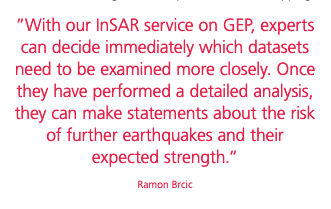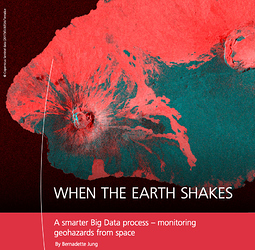The October 2019 edition of the DLR Magazine had a featured article “A smarter Big Data process – monitoring geohazards from space”, citing the work conducted on GEP by the DLR Earth Observation Center (EOC) team, and its applications in the Geohazards community.
WHEN THE EARTH SHAKES
A smarter Big Data process – monitoring geohazards from space
By Bernadette Jung
DLR Magazine, No. 162 · October 2019
As the end of year is close, this is an opportunity for us to celebrate a 5 years partnership with DLR on GEP, and pay homage to the pioneering service integration work conducted on the Platform by the DLR EOC team, with a highlight on the innovations brought to the community thanks to ESA sponsoring.
This collaboration delivers indeed a long track record of achievements, with some key milestones of that DLR endeavor restituted on our GEP Blog, for example, from initial users of the service for Interpreting the Layers of DLR’s InSAR Browse Service, from user return of experience as part of the 2017’s Volcano Trial Case, or from custom product delivery activities such as depicted in the Blog post Interferograms processed by the DLR’s High Resolution InSAR browse depict deformations after the November 12, 2017 M 7.3 earthquake at the Iran-Iraq border or in the related initiative designed for the GEP user community: Opportunity to monitor AOIs with high-resolution Sentinel-1 InSAR Browse service.
You can of course search the GEP Blog and find much more references on DLR’s support to the Geohazards community on GEP.
So we were delighted that the DLR Magazine article provides an extensive interview of Ramon Brcic on the use of GEP and the Sentinel-1 InSAR Browse products. As part of DLR EOC team, Ramon is one of the very first GEP users and contributors, working over 2014-2015 to integrate and configure DLR’s ‘Integrated Wide Area Processor’ (IWAP) software as a GEP Sentinel-1 InSAR Browse service.


Ramon Brcic, as part of DLR EOC team, is one of the very first GEP users and contributors (picture and citation excerpts from DLR Magazine, No. 162 · October 2019)
DLR currently maintains on GEP two flavors of the Sentinel-1 InSAR Browse service, that are greatly detailed in the article, and delivering data products freely accessible via the GEP portal:
- The Sentinel-1 Medium-Resolution InSAR Browse Service, operates at a resolution of 100 metres. It provides continuously updated mapping of the world’s most dangerous earthquake zones (currently about fourty percent of the Earth active seismic areas).
- The Sentinel-1 High-Resolution InSAR Browse Service operates at a resolution of 50 metres. It is monitoring 22 of the most active volcanoes worldwide.
Moreover the related Sentinel-1 InSAR Browse processing software baseline, also maintained on GEP, can be easilly deployed temporarily on a selected Cloud provider, in order to run ad-hoc production campaigns delivering custom products on the GEP Portal, either on the GEP Global App public area, or onto a given GEP user community which membership can be either open to all or based on community manager approval.
Alright, if you haven’t done so yet, time go to this brilliant DLR Magazine article and learn more from Ramon Brcic on the use of the Sentinel-1 InSAR Browse services on GEP!
Have a nice read: A smarter Big Data process – monitoring geohazards from space.

